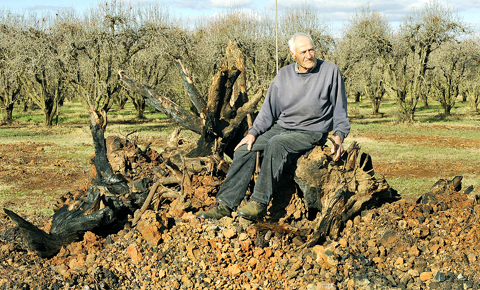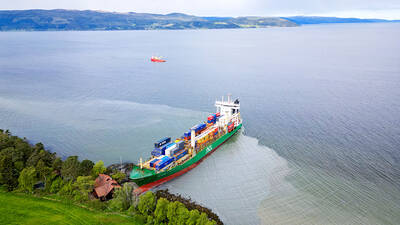Farmer Mazzareno Bisogni fights back tears as he stands among the remains of trees he planted 35 years ago, victims of a drought hitting “Australia’s Mississippi.”
Bisogni’s orchard lies in the heart of the once-mighty Murray-Darling river system which irrigates Australia’s food bowl, the vast southeastern corner responsible for 40 percent of agricultural output.
The eight-year “big dry,” the worst drought in a century, has devastated the region, an area covering 1.06 million square kilometers — the size of France and Spain combined.

PHOTO: AFP
Lack of water this year meant the fruit on Bisogni’s apple and pear trees in Victoria state literally cooked on their branches under the furious Australian sun, making them suitable only for jam.
Rather than leave the land, like many farmers along the Murray, the tenacious 78-year-old Italian migrant scaled back his operation so he could use limited water resources to cultivate export-quality produce for Asia.
“I couldn’t sleep for nights before pulling them out, I was tossing and turning” he said, pointing to the blackened branches of dozens of trees he bulldozed and burned.
“A pear tree has 100 years life [but] I have to pull them out. It broke my heart,” he said.
Tourist brochures for the Murray-Darling say Mark Twain likened the waterway to his beloved Mississippi during a visit in the 1890s.
But the US writer would struggle to make the comparison today, particularly since the one of the river’s paddleboats, the Cumberoona, had to stop operating three years ago when water levels became too shallow.
Sections of the river have become little more than stagnant pools as the drought continues, with banks eroded into crumbling dirt cliffs that leave the roots of gum trees exposed.
For three months this year, a toxic blue-green algal bloom leeched along 800km of the Murray, prompting warnings from authorities not to swim in the river.
Water levels are so low that the freshwater lakes near the Murray’s mouth in South Australia are turning acid as soil minerals are exposed to oxygen. The lakes are now below sea-level and only man-made barriers keep the ocean out.
Official figures show the number of farmers in the Murray-Darling fell 10 percent to 67,000 between 1996 and 2006 as drought and falling prices drove them from the region.
Australian Prime Minister Kevin Rudd describes the decline of the Murray-Darling as the “most practical impact of climate change across Australia,” the world’s driest inhabited continent.
Environmentalists also blame fertilizer run-off and decades of wasteful irrigation practices, as well as short-term policies by the three state governments on the river’s route that ignore the waterway’s overall health.
Rudd’s national government has attempted to address the problem by placing the river system’s management under a centralized body, the Murray-Darling Basin Authority (MDBA).
It has also spent hundreds of millions of dollars buying out irrigators’ water allocations to try to restore the so-called “environmental flows” needed to restore the river’s health.
But locals say what they really need is rain, a commodity the authority warns is likely to be scarce for a long time to come.
This month’s MDBA drought update said river inflows remained two-thirds below their long-term average and would worsen if forecasts of a dry “El Nino” weather pattern proved correct.
“With another El Nino event predicted to bring dry conditions, the overall outlook for the 2009-to-2010 water year unfortunately remains very poor,” authority chief executive Rob Freeman said.
For Bisogni, still working his farm long past his planned retirement and forced to borrow A$2.3 million (US$1.9 million) last year to keep it operating, it amounts to a grinding struggle.

BACKLASH: The National Party quit its decades-long partnership with the Liberal Party after their election loss to center-left Labor, which won a historic third term Australia’s National Party has split from its conservative coalition partner of more than 60 years, the Liberal Party, citing policy differences over renewable energy and after a resounding loss at a national election this month. “Its time to have a break,” Nationals leader David Littleproud told reporters yesterday. The split shows the pressure on Australia’s conservative parties after Prime Minister Anthony Albanese’s center-left Labor party won a historic second term in the May 3 election, powered by a voter backlash against US President Donald Trump’s policies. Under the long-standing partnership in state and federal politics, the Liberal and National coalition had shared power

NO EXCUSES: Marcos said his administration was acting on voters’ demands, but an academic said the move was emotionally motivated after a poor midterm showing Philippine President Ferdinand Marcos Jr yesterday sought the resignation of all his Cabinet secretaries, in a move seen as an attempt to reset the political agenda and assert his authority over the second half of his single six-year term. The order came after the president’s allies failed to win a majority of Senate seats contested in the 12 polls on Monday last week, leaving Marcos facing a divided political and legislative landscape that could thwart his attempts to have an ally succeed him in 2028. “He’s talking to the people, trying to salvage whatever political capital he has left. I think it’s

Polish presidential candidates offered different visions of Poland and its relations with Ukraine in a televised debate ahead of next week’s run-off, which remains on a knife-edge. During a head-to-head debate lasting two hours, centrist Warsaw Mayor Rafal Trzaskowski, from Polish Prime Minister Donald Tusk’s governing pro-European coalition, faced the Eurosceptic historian Karol Nawrocki, backed by the right-wing populist Law and Justice party (PiS). The two candidates, who qualified for the second round after coming in the top two places in the first vote on Sunday last week, clashed over Poland’s relations with Ukraine, EU policy and the track records of their

UNSCHEDULED VISIT: ‘It’s a very bulky new neighbor, but it will soon go away,’ said Johan Helberg of the 135m container ship that run aground near his house A man in Norway awoke early on Thursday to discover a huge container ship had run aground a stone’s throw from his fjord-side house — and he had slept through the commotion. For an as-yet unknown reason, the 135m NCL Salten sailed up onto shore just meters from Johan Helberg’s house in a fjord near Trondheim in central Norway. Helberg only discovered the unexpected visitor when a panicked neighbor who had rung his doorbell repeatedly to no avail gave up and called him on the phone. “The doorbell rang at a time of day when I don’t like to open,” Helberg told television